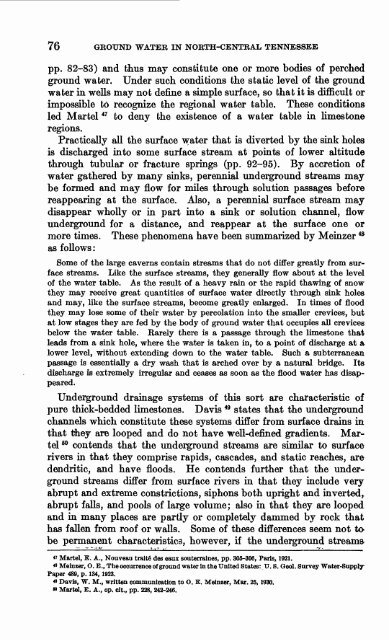GROUND WATER IN NORTH-CENTRAL TENNESSEE
GROUND WATER IN NORTH-CENTRAL TENNESSEE
GROUND WATER IN NORTH-CENTRAL TENNESSEE
Create successful ePaper yourself
Turn your PDF publications into a flip-book with our unique Google optimized e-Paper software.
76 <strong>GROUND</strong> <strong>WATER</strong> <strong>IN</strong> <strong>NORTH</strong>-<strong>CENTRAL</strong> <strong>TENNESSEE</strong><br />
pp. 82-83) and thus may constitute one or more bodies of perched<br />
ground water. Under such conditions the static level of the ground<br />
water in wells may not define a simple surface, so that it is difficult or<br />
impossible to recognize the regional water table. These conditions<br />
led Martel 47 to deny the existence of a water table in limestone<br />
regions.<br />
Practically all the surface water that is diverted by the sink holes<br />
is discharged into some surface stream at points of lower altitude<br />
through tubular or fracture springs (pp. 92-95). By accretion of<br />
water gathered by many sinks, perennial underground streams may<br />
be formed and may flow for miles through solution passages before<br />
reappearing at the surface. Also, a perennial surface stream may<br />
disappear wholly or in part into a sink or solution channel, flow<br />
underground for a distance, and reappear at the surface one or<br />
more times. These phenomena have been summarized by Meinzer **<br />
as follows:<br />
Some of the large caverns contain streams that do not differ greatly from sur<br />
face streams. Like the surface streams, they generally flow about at the level<br />
of the water table. As the result of a heavy rain or the rapid thawing of snow<br />
they may receive great quantities of surface water directly through sink holes<br />
and may, like the surface streams, become greatly enlarged. In times of flood<br />
they may lose some of their water by percolation into the smaller crevices, but<br />
at low stages they are fed by the body of ground water that occupies all crevices<br />
below the water table. Barely there is a passage through the limestone that<br />
leads from a sink hole, where the water is taken in, to a point of discharge at a<br />
lower level, without extending down to the water table. Such a subterranean<br />
passage is essentially a dry wash that is arched over by a natural bridge. Its<br />
discharge is extremely irregular and ceases as soon as the flood water has disap<br />
peared.<br />
Underground drainage systems of this sort are characteristic of<br />
pure thick-bedded limestones. Davis 4fl states that the underground<br />
channels which constitute these systems differ from surface drains in<br />
that they are looped and do not have well-defined gradients. Mar<br />
tel 60 contends that the underground streams are similar to surface<br />
rivers in that they comprise rapids, cascades, and static reaches, are<br />
dendritic, and have floods. He contends further that the under<br />
ground streams differ from surface rivers in that they include very<br />
abrupt and extreme constrictions, siphons both upright and inverted,,<br />
abrupt falls, and pools of large volume; also in that they are looped<br />
and in many places are partly or completely dammed by rock that<br />
has fallen from roof or walls. Some of these differences seem not to-<br />
be permanent characteristics, however, if the underground streama<br />
« Martel, E. A., Nouveau traits des eaux souterraines, pp. 305-306, Paris, 1921.<br />
« Meinzer, O. E., The occurrence of ground water in the United States: TJ. S. Geol. Survey Water-Supply-<br />
Paper 489, p. 134, 1923.<br />
« Davis, W. M., written communication to O. E. Meinzer, Mar. 25,1930.<br />
M Martel, E. A., op. cit., pp. 228, 242-246.

















